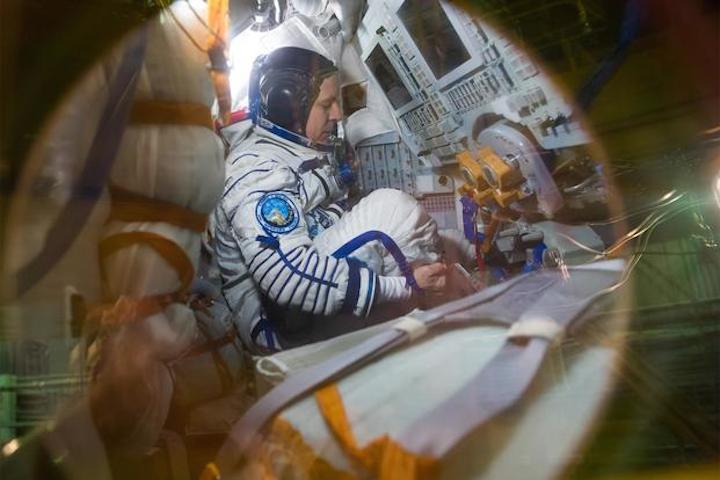4.01.2018

In the Integration Building at the Baikonur Cosmodrome in Kazakhstan, crewmember Jack Fischer of NASA sits in the Soyuz MS-04 spacecraft April 6 as part of pre-launch preparations. (NASA/Gagarin Cosmonaut Training Center/Andrey Shelepin)
-
Sometimes the Air Force's brightest minds have to leave the planet to conduct cutting-edge experiments that are out of this world.
That was the nearly six-month mission for Col. Jack Fischer, an active-duty airman and a NASA astronaut who recently returned from the International Space Station after he and a team of astronauts oversaw, orchestrated or took part in more than 330 operations, as Fischer described the science experiments.
"We go up there to get science done," said Fischer, an experienced F-15E Strike Eagle and F-22 Raptor pilot.
"Everything else is really support and maintenance of the space station as a national laboratory so that we can get the science done," he told Military.com on Monday.
"That's kind of the neat thing being up there -- you don't know which [new science] you're doing day to day is going to have the biggest impact on humanity," Fischer said. "We may be only connecting a cable, or dissecting something. It's a wide variety. But the reward is, you're contributing to something bigger than yourself."
EXPERIMENTS BEYOND
Fischer was selected in 2009 as part of NASA's 20th astronaut class, and completed astronaut candidate training in July 2011.
He launched from the Baikonur Cosmodrome in Kazakhstan on April 20 to the International Space Station with Russian cosmonaut Fyodor Yurchikhin, according to his NASA profile. While in space for 136 days, Fischer also took two spacewalks outside the station.
The experiments, Fischer said, ranged from anything that could alter basic day-to-day human habits, to far-out future endeavors imagined only in books and movies.
Some of the experiments touched upon Earth sensing -- watching and monitoring polar ice caps melting, for example -- to human physiology experiments, to the latest and greatest in futuristic tech.
"Some of those technologies have obvious benefits on Earth," Fischer said during an interview at the Pentagon. "We always joke that yesterday's coffee is tomorrow's coffee ... because on the space station, we cycle through our urine and then make it water again."
In many parts of the globe, such as the U.S., South Africa and Australia, the same practice applies where wastewater is turned into drinking water.
THE PERFECT TEST ENVIRONMENT
In the human physiology experiment realm -- in which astronauts test or alter diseases and drugs -- one pivotal example was testing azonafide-based antibody-drug conjugates, Fischer said.
More simply put: "I called it the 'cancer seeking missile' [drug]," he said. "It was a new drug that basically sought out the antibodies in cancerous lung tissue and destroyed the cancer cells and not the lung tissue. So it was kind of smart chemotherapy."
For Fischer, this hit close to home. One of his two daughters was a cancer patient, but has been cancer free for two years.
"Watching my kid go through cancer, that one was special to me. Anything that's going to give us the capability to have chemo that isn't like dropping a nuke in your body and destroying everything … that one was special," he said.
Fischer said the astronauts were also looking at a new drug that encouraged rapid bone growth.
"It would be used for battlefield injuries, or in trauma centers and not just to stop bone loss -- which had always been a problem for astronauts [too]," he said.
Why is space the best environment to seek next-generation human treatment?
"With different types of viruses, protein crystals, lung tissue -- all of those type of items -- they actually grow perfectly in orbit because there's no effect of gravity," Fischer said.
The "microgravity effect" that allows for a perfect structure gives researchers the ability to "understand and more effectively go after different types of cures," he said.
NEW TECHNOLOGIES
New engineering and design practices also have positive outcomes in space, Fischer said.
In movies such as "Star Wars," lasers -- or high-energy beams traveling at the speed of light -- are standard weapons. On the International Space Station, lasers have been used for research and development, including a way to create new metal combinations that could one day be used for transportation, infrastructure, maybe even aircraft.
"There's one [program] called ELF -- Electrostatic Levitation Furnace," Fischer said. "They would levitate little balls of metal, shoot them with a laser, melt it, and then supercool them to create new alloys -- lighter and stronger than anything we can create here on Earth."
Lasers have always been a technology scientists have tested in space, the astronaut said. "But with that one, we're trying to find new alloys, and that is the most effective way to rapidly heat the materials."
MILITARY MOTIVATION
As a former test pilot at Edwards Air Force Base, California, as well as Eglin Air Force Base, Florida, Fischer said the mission gets done because it has to.
"I think … that all throughout as soon as you join the military, the reason we grow [individually] in the military is because we're stretched, beyond what we think our limits are," he said.
Fischer served two combat tours following 9/11 in support of Operation Enduring Freedom and Operation Southern Watch over Afghanistan and Iraq.
NASA advanced his willingness to serve.
"In doing so, you learn how to grow and get better at stuff you never even thought of before. I think NASA continued that [for me] and my preparation for the space station -- learning to fly a spaceship in Russian is not something I would have [seen] myself doing 20 years ago," Fischer said.
"But as long as you know how to learn, and you're eager to be a part of the team and make a difference, it's really not a roadblock to progressing," he said.
Quelle: Military.com
